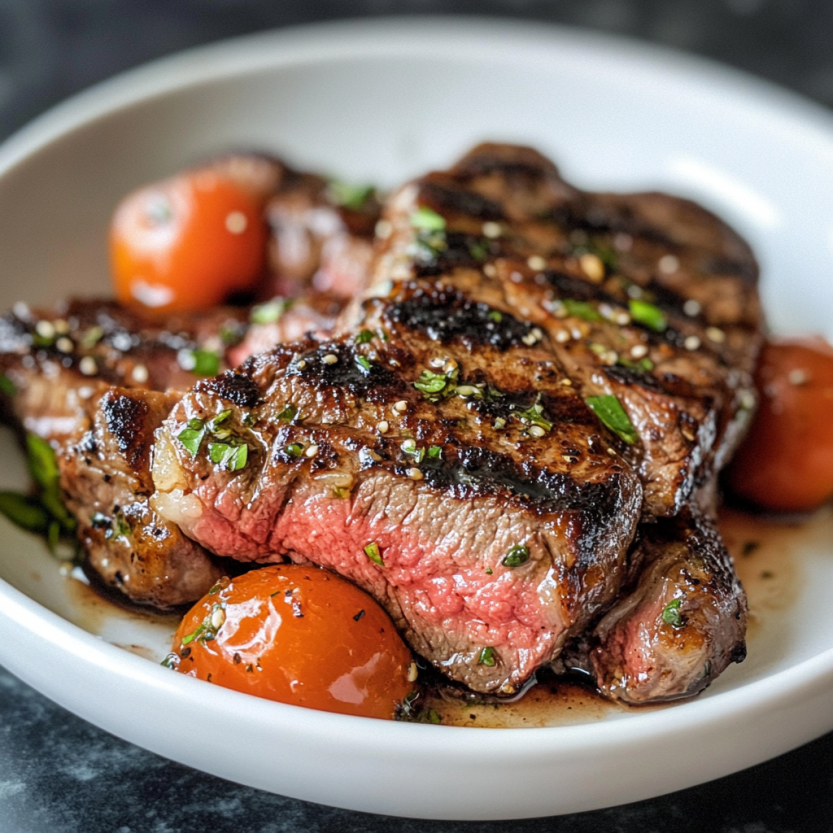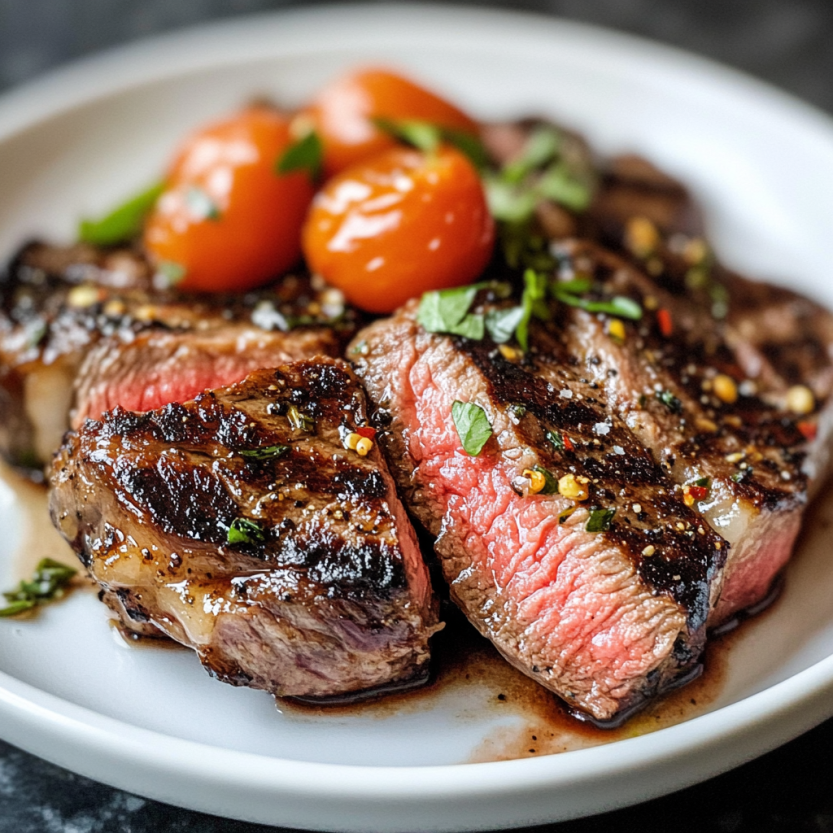 Bookmark
Bookmark
This perfect ribeye steak transforms your kitchen into a steakhouse in just 35 minutes. The technique delivers a mouthwatering crust while keeping the inside tender and juicy. My family now requests this buttery, garlicky masterpiece instead of expensive restaurant steaks.
I discovered this method after years of disappointing home-cooked steaks. After perfecting the timing, my husband now claims these are better than any restaurant steaks we've had. The secret is in the butter basting technique.
Ingredients
- Ribeye steaks: 1 inch thick creates the ideal balance between exterior crust and juicy interior
- Salt: enhances the natural beef flavor and helps create the perfect crust
- Ground black pepper: adds classic steakhouse flavor that complements the richness
- Olive oil: prevents sticking and helps create even browning on the surface
- Butter: creates the rich flavor base that makes this steak restaurant quality
- Fresh minced garlic: infuses the butter with aromatic flavor that penetrates the meat
Step-by-Step Instructions
- Room Temperature Rest:
- Allow steaks to sit at room temperature for 20-30 minutes. This critical step ensures even cooking as cold steaks will cook unevenly with overcooked exteriors and undercooked centers. The steaks should feel cool but not cold to the touch before cooking.
- Seasoning Preparation:
- Pat steaks completely dry with paper towels. This step is vital as excess moisture prevents proper searing. Season generously with salt and pepper on all sides including the edges. The seasoning should form an even layer that will help develop the flavorful crust.
- Pan Preparation:
- Brush the skillet or grill pan with olive oil and heat over medium high heat until the oil shimmers and just starts to smoke. The proper temperature creates immediate searing without burning. A cast iron pan works best because it retains heat consistently.
- Initial Searing:
- Place steaks carefully in the hot pan and cook undisturbed for exactly one minute. Rotate 90 degrees and cook one more minute to create professional crosshatch grill marks. The steak should release easily from the pan when properly seared.
- Butter Basting:
- Add butter and minced garlic to the pan allowing it to melt completely. Tilt the pan slightly and repeatedly spoon the sizzling garlic butter over the steaks. This technique bathes the meat in flavor while helping it cook evenly. Continue basting for several minutes until butter becomes fragrant and lightly browned.
- Flipping and Finishing:
- Flip steaks gently with tongs and repeat the basting process. Cook to your desired temperature using a meat thermometer for precision. The steak will continue cooking during rest so remove it about 5 degrees before your target temperature.
- Resting Period:
- Remove steaks from heat and tent loosely with foil for a full 5 minutes. This allows juices to redistribute throughout the meat rather than spilling out when cut. Skipping this step results in dry steak regardless of how perfectly you cooked it.
 Bookmark
Bookmark
My favorite part of this recipe is the moment when the butter hits the pan and the garlic becomes fragrant. That aroma instantly transforms my kitchen into a steakhouse experience. My husband always appears in the kitchen within seconds of that smell reaching the living room.
Perfect Side Pairings
The ideal steakhouse experience includes thoughtfully paired sides. Creamy mashed potatoes provide the perfect canvas for soaking up the flavorful garlic butter sauce. Roasted vegetables add color and nutritional balance to the plate. For a complete experience consider adding a simple green salad with a light vinaigrette to cut through the richness of the steak.
 Bookmark
Bookmark
Temperature Guide For Perfect Doneness
Understanding steak temperatures is crucial for achieving your ideal doneness. Rare steak (130-135°F) has a cool red center and maximum juiciness. Medium rare (135°F) offers a warm red center with optimal flavor and tenderness. Medium (140°F) provides a warm pink center that appeals to most diners. Well done (155°F) has little to no pink but can be kept juicy with proper butter basting. The temperature will rise approximately 5 degrees during resting so always remove from heat slightly before your target temperature.
Selecting The Perfect Ribeye
The quality of your steak makes a significant difference in this simple recipe. Look for steaks with abundant marbling which appears as thin white streaks of fat throughout the meat. This marbling melts during cooking creating flavor and juiciness. Prime grade offers the most marbling followed by choice grade which is more accessible and still excellent for this recipe. The thickness matters too with 1 inch being ideal for the timing in this recipe. Thicker steaks will require longer cooking and possibly finishing in the oven.
Troubleshooting Common Steak Issues
Creating restaurant quality steak at home can involve some learning. If your steak develops too much char before reaching the desired internal temperature your heat is likely too high. Lower the temperature for your next attempt. For steaks that seem tough after cooking ensure you allow proper resting time and slice against the grain when serving. If your steak lacks flavor consider enhancing the seasoning with garlic powder or fresh herbs added to the butter. For maximum tenderness never skip the room temperature rest before cooking.
Frequently Asked Questions About Recipes
- → How do I know when my ribeye steak is done cooking?
The most reliable method is using a digital meat thermometer inserted into the center of the steak. For rare, aim for 130-135°F; medium-rare 135°F; medium 140°F; and well-done 155°F. Remember that the internal temperature will rise slightly during the resting period.
- → Why should steaks rest at room temperature before cooking?
Allowing steaks to sit at room temperature for 20-30 minutes before cooking promotes even heat distribution throughout the meat. Cold steaks placed directly on heat can result in uneven cooking—overcooked exteriors with undercooked centers.
- → What's the best way to reheat leftover steak?
Avoid microwaving as it tends to toughen the meat. Instead, reheat gently in a cast iron skillet or bake in the oven at a low temperature (around 250°F) until warmed through. This gentle reheating helps maintain the steak's tenderness and juiciness.
- → Why is basting the steak with butter important?
Basting with melted butter and garlic adds tremendous flavor while helping to create a beautiful caramelized crust. The fat in the butter also helps conduct heat evenly across the steak's surface and keeps the meat moist and tender.
- → How long should ribeye steak rest after cooking?
Allow the steak to rest for at least 5 minutes under foil after cooking. This resting period is crucial as it allows the juices to redistribute throughout the meat instead of spilling out when cut, resulting in a more flavorful and juicy steak.
- → Can I freeze cooked ribeye steak?
Yes, cooked ribeye can be frozen in airtight containers for up to 3 months. For best quality, wrap tightly in plastic wrap and then place in a freezer bag to prevent freezer burn. Thaw in the refrigerator before gently reheating.
